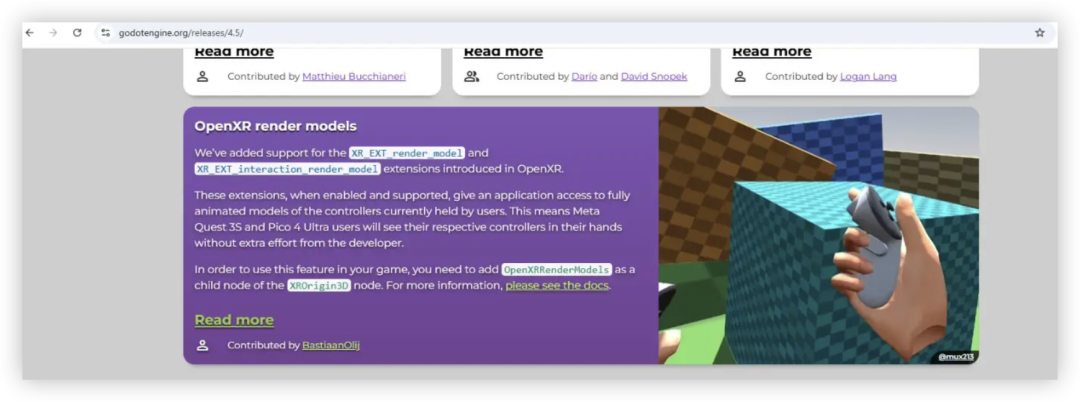Godot And Khronos: Major OpenXR Update For XR Development

Have you dreamed of crafting breathtaking immersive experiences where virtual and real worlds blend seamlessly? That dream is accelerating into reality.
Exciting news:
Key OpenXR features in the open‑source Godot engine have reached production readiness. Developers worldwide can now tap into them—ushering in a new era of XR development.
OpenXR Render Models: Godot 4.5 is here for you
Imagine your app showing the correct controller model for whatever VR/AR device the user holds—down to detailed animations. That’s no longer a wish.
Godot 4.5 integrates the OpenXR Render Model extension, a milestone for cross‑platform XR.

Godot 4.5 Render Models
Godot’s early work played a crucial role in validating the API design, helping
Valve and
PICO refine their runtimes. This feature has passed rigorous testing and runs flawlessly on SteamVR and PICO. Render Models are a key step toward a truly unified XR experience. PICO’s OpenXR tech lead praised Godot’s early support as a valuable reference for implementing Render Models efficiently.
Spatial Entities: the magic wand of mixed reality
Perhaps the most eye‑catching update is Godot 4.6 dev 1’s support for the OpenXR Spatial Entities extension. This system empowers developers to build MR experiences where virtual content persists, aligns with the real world, and understands space. It includes:
-
Spatial Anchors:
Virtual objects can “remember” real‑world positions and return precisely, anytime. -
Plane Detection:
Easily detect floors, walls, and other surfaces—unlocking new interaction possibilities. -
Marker Tracking:
Use QR codes and other markers to tightly align virtual with real.
At SIGGRAPH, a Godot OpenXR spatial anchors demo running on PICO showed not just Khronos API maturity but complete runtime readiness. Google Senior Software Engineer Nihav Jain said Godot’s timely feedback and API testing offered “critical insights” validating Spatial Entities design and runtime implementations. PICO’s OpenXR lead Liu Zhipeng expressed pride that PICO, the first runtime with implementation support, is enhancing cross‑platform spatial awareness for XR developers through this partnership.
OpenXR 1.1 and advanced features: performance and visuals together
Godot 4.6 also embraces OpenXR 1.1. Developers benefit from the latest spec improvements. We implemented frame composition, providing runtimes with depth buffers and motion vectors—delivering better reprojection quality and stable visuals even at lower frame rates.
Work continues on Quad Views (foveated/embedded rendering), which can boost visual quality where the user focuses while balancing overall performance.
Goodbye multi‑APK pain: unified Android XR deployment
Once, Android XR development was painful—different devices often demanded separate APKs. Now,
Godot brings a revolutionary solution: one APK for all Android XR devices that support OpenXR.
This is OpenXR’s original promise—true cross‑platform compatibility. Maintaining multiple builds per device was needless friction, especially for education and demos. Godot’s breakthrough meaningfully boosts developer efficiency.
Khronos and Godot: open collaboration for the future
The Godot OpenXR integration is a joint effort between the open‑source Godot community and the Khronos Group, the consortium behind the OpenXR standard. By implementing these features in a production engine used by thousands, we help developers:
-
Validate API design:
Real‑world use surfaces edge cases and usability issues isolated tests miss. -
Accelerate runtime development:
Our implementation serves as a valuable reference for runtime vendors. -
Integrate developer feedback:
Community insights directly shape the final spec.
Through funding and support, Khronos ensures open standards like OpenXR continually evolve with developer input.
The XR horizon
With these features landing in Godot 4.6, our sights are set on what’s next for OpenXR:
-
Multi‑vendor body tracking standardization
-
Spatial Entities Phase 2
-
Multi‑app support
-
Improved universal controller support
The Godot OpenXR effort showcases tight collaboration among standards bodies, runtime vendors, and engine developers—a proven path to better APIs and faster adoption. As these features roll out globally, the OpenXR ecosystem is becoming what it was meant to be: a unified, mature cross‑platform XR standard.
分享文章
3篇相关文章
PICO Officially Partners with Blender! XR Content Creation Enters a Historic Acceleration?
2025-07-23
PICO and the Blender Foundation join forces, marking a new stage for XR content creation and bringing unprecedented opportunities to global developers.
Varjo XR-4: How MR Headsets are Reshaping Future Military Training?
2025-10-09
The Varjo XR-4 series MR headset, designed specifically for military training, revolutionizes simulation methods across land, sea, and air dimensions, enhancing training realism and efficiency.
Farewell Controllers! BEATABLE MR Rhythm Game Arrives - Play Music with Your Hands!
2025-07-29
XR Games launches the groundbreaking MR rhythm game BEATABLE on Meta Quest platform. This controller-free game lets you immerse in music through gestures, turning real tabletops into your personal instruments. A revolutionary gaming experience is about to begin!